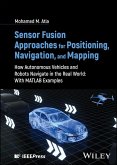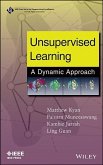Jerome Dinet
Information Retrieval in Digital Environments
Jerome Dinet
Information Retrieval in Digital Environments
- Gebundenes Buch
- Merkliste
- Auf die Merkliste
- Bewerten Bewerten
- Teilen
- Produkt teilen
- Produkterinnerung
- Produkterinnerung
Information retrieval is a central and essential activity. It is indeed difficult to find a human activity that does not need to retrieve information in an environment which is often increasingly digital: moving and navigating, learning, having fun, communicating, informing, making a decision, etc. Most human activities are intimately linked to our ability to search quickly and effectively for relevant information, the stakes are sometimes extremely important: passing an exam, voting, finding a job, remaining autonomous, being socially connected, developing a critical spirit, or simply surv.
Andere Kunden interessierten sich auch für
![Sensor Fusion Approaches for Positioning, Navigation, and Mapping Sensor Fusion Approaches for Positioning, Navigation, and Mapping]() Mohamed M AtiaSensor Fusion Approaches for Positioning, Navigation, and Mapping129,99 €
Mohamed M AtiaSensor Fusion Approaches for Positioning, Navigation, and Mapping129,99 €![Communications and Multimedia Security II Communications and Multimedia Security II]() Patrick Horster (ed.)Communications and Multimedia Security II159,99 €
Patrick Horster (ed.)Communications and Multimedia Security II159,99 €![Digital Signal Compression Digital Signal Compression]() William A PearlmanDigital Signal Compression102,99 €
William A PearlmanDigital Signal Compression102,99 €![Unsupervised Learning Unsupervised Learning]() Matthew KyanUnsupervised Learning129,99 €
Matthew KyanUnsupervised Learning129,99 €![Semantic Web Technologies Semantic Web Technologies]() John DaviesSemantic Web Technologies124,99 €
John DaviesSemantic Web Technologies124,99 €![Hard Disk Drive Servo Systems Hard Disk Drive Servo Systems]() Ben M. ChenHard Disk Drive Servo Systems157,99 €
Ben M. ChenHard Disk Drive Servo Systems157,99 €![Information Integration with Ontologies Information Integration with Ontologies]() Dieter FenselInformation Integration with Ontologies141,99 €
Dieter FenselInformation Integration with Ontologies141,99 €-
-
-
Information retrieval is a central and essential activity. It is indeed difficult to find a human activity that does not need to retrieve information in an environment which is often increasingly digital: moving and navigating, learning, having fun, communicating, informing, making a decision, etc. Most human activities are intimately linked to our ability to search quickly and effectively for relevant information, the stakes are sometimes extremely important: passing an exam, voting, finding a job, remaining autonomous, being socially connected, developing a critical spirit, or simply surv.
Produktdetails
- Produktdetails
- Verlag: Wiley
- Seitenzahl: 304
- Erscheinungstermin: 15. September 2014
- Englisch
- Abmessung: 241mm x 159mm x 20mm
- Gewicht: 418g
- ISBN-13: 9781848216983
- ISBN-10: 184821698X
- Artikelnr.: 40928113
- Herstellerkennzeichnung
- Libri GmbH
- Europaallee 1
- 36244 Bad Hersfeld
- gpsr@libri.de
- Verlag: Wiley
- Seitenzahl: 304
- Erscheinungstermin: 15. September 2014
- Englisch
- Abmessung: 241mm x 159mm x 20mm
- Gewicht: 418g
- ISBN-13: 9781848216983
- ISBN-10: 184821698X
- Artikelnr.: 40928113
- Herstellerkennzeichnung
- Libri GmbH
- Europaallee 1
- 36244 Bad Hersfeld
- gpsr@libri.de
Jérôme Dinet is a Psychologist and Assistant Professor in cognitive psychology and ergonomics at the University of Lorraine in France.
CHAPTER 1. INFORMATION RETRIEVAL IN DIGITAL ENVIRONMENTS: DEBATE AND
SCIENTIFIC DIRECTIONS 1
1.1. Information retrieval, current and future challenges 1
1.2. What are we talking about? 3
1.3. Interaction and navigation at the heart of information retrieval 7
1.4. Why should we be interested in information retrieval? 9
1.4.1. Economy: maximize profitability and minimize risks 10
1.4.2. Information technology: mathematical concepts of the relevance of
information 12
1.4.3. Robotics: improving movements and interactions 14
CHAPTER 2. CONCEPTUAL AND METHODOLOGICAL APPROACHES TO INFORMATION
RETRIEVAL IN
DIGITAL ENVIRONMENTS 19
2.1. The approaches of information sciences: the precursors 19
2.2. The Marchionini sequential iterative model 21
2.3. The holistic model of Kuhlthau 23
2.4. The first studies of psychology and cognitive ergonomics 26
2.5. The cyclic model of David, Song, Hayes and Fredin 31
2.6. The skills-centered model of Brand-Gruwel 33
2.7. Kitajima's predictive model 36
2.8. The hyper-specialized model of Sharit, Hernandez, Czaja and Pirolli 39
2.9. The Landscape Model "diversion" by Dinet 42
CHAPTER 3. INFORMATION RETRIEVAL: PSYCHOERGONOMIC APPROACH 49
3.1. Introduction 49
3.2. Identifying difficulties in modifying interfaces 51
3.2.1. Hierarchical task analysis 52
3.2.2. Analysis of the end users' behavior 55
3.2.3. Implications for the (re)design of interfaces 61
3.3. Anticipating the needs of users 63
3.3.1. "If we built it, they will come" 64
3.3.2. The analysis of users' expectations and behaviors 65
3.3.3. Prospective ergonomics and technological innovation 70
3.3.4. Anticipating and understanding the needs of users: the method of
staff made up of community experts 73
3.3.5. An example of application of the method of staff made up of
community experts 76
3.4. The motor dimension 79
3.4.1. Motor ability and information retrieval in digital environments 79
3.4.2. Toward a lexicon of intuitive gestures 85
3.5. The social dimension and collaborative 88
3.5.1. From individual research to collaborative information retrieval 89
3.5.2. Benefits and limitations of collaborative information retrieval 90
3.6. Impact of emotional ties between collaborators 92
3.6.1. Ties between collaborators and impact on information retrieval 94
3.6.2. "RCI-Web": software to assist information retrieval 97
3.7. The cultural dimension 102
3.7.1. About the importance of the home page 102
3.7.2. Culture and design of Websites' home pages: an ergonomic inspection
105
3.7.3. Information retrieval culture and behavior navigation 107
3.8. The visual exploration strategies109
3.8.1. Impact of the typographical marking (bottom-up approach) 112
3.8.2. Impact of the mental model (top-down approach) 117
CONCLUSION 123
BIBLIOGRAPHY 125
INDEX 165
SCIENTIFIC DIRECTIONS 1
1.1. Information retrieval, current and future challenges 1
1.2. What are we talking about? 3
1.3. Interaction and navigation at the heart of information retrieval 7
1.4. Why should we be interested in information retrieval? 9
1.4.1. Economy: maximize profitability and minimize risks 10
1.4.2. Information technology: mathematical concepts of the relevance of
information 12
1.4.3. Robotics: improving movements and interactions 14
CHAPTER 2. CONCEPTUAL AND METHODOLOGICAL APPROACHES TO INFORMATION
RETRIEVAL IN
DIGITAL ENVIRONMENTS 19
2.1. The approaches of information sciences: the precursors 19
2.2. The Marchionini sequential iterative model 21
2.3. The holistic model of Kuhlthau 23
2.4. The first studies of psychology and cognitive ergonomics 26
2.5. The cyclic model of David, Song, Hayes and Fredin 31
2.6. The skills-centered model of Brand-Gruwel 33
2.7. Kitajima's predictive model 36
2.8. The hyper-specialized model of Sharit, Hernandez, Czaja and Pirolli 39
2.9. The Landscape Model "diversion" by Dinet 42
CHAPTER 3. INFORMATION RETRIEVAL: PSYCHOERGONOMIC APPROACH 49
3.1. Introduction 49
3.2. Identifying difficulties in modifying interfaces 51
3.2.1. Hierarchical task analysis 52
3.2.2. Analysis of the end users' behavior 55
3.2.3. Implications for the (re)design of interfaces 61
3.3. Anticipating the needs of users 63
3.3.1. "If we built it, they will come" 64
3.3.2. The analysis of users' expectations and behaviors 65
3.3.3. Prospective ergonomics and technological innovation 70
3.3.4. Anticipating and understanding the needs of users: the method of
staff made up of community experts 73
3.3.5. An example of application of the method of staff made up of
community experts 76
3.4. The motor dimension 79
3.4.1. Motor ability and information retrieval in digital environments 79
3.4.2. Toward a lexicon of intuitive gestures 85
3.5. The social dimension and collaborative 88
3.5.1. From individual research to collaborative information retrieval 89
3.5.2. Benefits and limitations of collaborative information retrieval 90
3.6. Impact of emotional ties between collaborators 92
3.6.1. Ties between collaborators and impact on information retrieval 94
3.6.2. "RCI-Web": software to assist information retrieval 97
3.7. The cultural dimension 102
3.7.1. About the importance of the home page 102
3.7.2. Culture and design of Websites' home pages: an ergonomic inspection
105
3.7.3. Information retrieval culture and behavior navigation 107
3.8. The visual exploration strategies109
3.8.1. Impact of the typographical marking (bottom-up approach) 112
3.8.2. Impact of the mental model (top-down approach) 117
CONCLUSION 123
BIBLIOGRAPHY 125
INDEX 165
CHAPTER 1. INFORMATION RETRIEVAL IN DIGITAL ENVIRONMENTS: DEBATE AND
SCIENTIFIC DIRECTIONS 1
1.1. Information retrieval, current and future challenges 1
1.2. What are we talking about? 3
1.3. Interaction and navigation at the heart of information retrieval 7
1.4. Why should we be interested in information retrieval? 9
1.4.1. Economy: maximize profitability and minimize risks 10
1.4.2. Information technology: mathematical concepts of the relevance of
information 12
1.4.3. Robotics: improving movements and interactions 14
CHAPTER 2. CONCEPTUAL AND METHODOLOGICAL APPROACHES TO INFORMATION
RETRIEVAL IN
DIGITAL ENVIRONMENTS 19
2.1. The approaches of information sciences: the precursors 19
2.2. The Marchionini sequential iterative model 21
2.3. The holistic model of Kuhlthau 23
2.4. The first studies of psychology and cognitive ergonomics 26
2.5. The cyclic model of David, Song, Hayes and Fredin 31
2.6. The skills-centered model of Brand-Gruwel 33
2.7. Kitajima's predictive model 36
2.8. The hyper-specialized model of Sharit, Hernandez, Czaja and Pirolli 39
2.9. The Landscape Model "diversion" by Dinet 42
CHAPTER 3. INFORMATION RETRIEVAL: PSYCHOERGONOMIC APPROACH 49
3.1. Introduction 49
3.2. Identifying difficulties in modifying interfaces 51
3.2.1. Hierarchical task analysis 52
3.2.2. Analysis of the end users' behavior 55
3.2.3. Implications for the (re)design of interfaces 61
3.3. Anticipating the needs of users 63
3.3.1. "If we built it, they will come" 64
3.3.2. The analysis of users' expectations and behaviors 65
3.3.3. Prospective ergonomics and technological innovation 70
3.3.4. Anticipating and understanding the needs of users: the method of
staff made up of community experts 73
3.3.5. An example of application of the method of staff made up of
community experts 76
3.4. The motor dimension 79
3.4.1. Motor ability and information retrieval in digital environments 79
3.4.2. Toward a lexicon of intuitive gestures 85
3.5. The social dimension and collaborative 88
3.5.1. From individual research to collaborative information retrieval 89
3.5.2. Benefits and limitations of collaborative information retrieval 90
3.6. Impact of emotional ties between collaborators 92
3.6.1. Ties between collaborators and impact on information retrieval 94
3.6.2. "RCI-Web": software to assist information retrieval 97
3.7. The cultural dimension 102
3.7.1. About the importance of the home page 102
3.7.2. Culture and design of Websites' home pages: an ergonomic inspection
105
3.7.3. Information retrieval culture and behavior navigation 107
3.8. The visual exploration strategies109
3.8.1. Impact of the typographical marking (bottom-up approach) 112
3.8.2. Impact of the mental model (top-down approach) 117
CONCLUSION 123
BIBLIOGRAPHY 125
INDEX 165
SCIENTIFIC DIRECTIONS 1
1.1. Information retrieval, current and future challenges 1
1.2. What are we talking about? 3
1.3. Interaction and navigation at the heart of information retrieval 7
1.4. Why should we be interested in information retrieval? 9
1.4.1. Economy: maximize profitability and minimize risks 10
1.4.2. Information technology: mathematical concepts of the relevance of
information 12
1.4.3. Robotics: improving movements and interactions 14
CHAPTER 2. CONCEPTUAL AND METHODOLOGICAL APPROACHES TO INFORMATION
RETRIEVAL IN
DIGITAL ENVIRONMENTS 19
2.1. The approaches of information sciences: the precursors 19
2.2. The Marchionini sequential iterative model 21
2.3. The holistic model of Kuhlthau 23
2.4. The first studies of psychology and cognitive ergonomics 26
2.5. The cyclic model of David, Song, Hayes and Fredin 31
2.6. The skills-centered model of Brand-Gruwel 33
2.7. Kitajima's predictive model 36
2.8. The hyper-specialized model of Sharit, Hernandez, Czaja and Pirolli 39
2.9. The Landscape Model "diversion" by Dinet 42
CHAPTER 3. INFORMATION RETRIEVAL: PSYCHOERGONOMIC APPROACH 49
3.1. Introduction 49
3.2. Identifying difficulties in modifying interfaces 51
3.2.1. Hierarchical task analysis 52
3.2.2. Analysis of the end users' behavior 55
3.2.3. Implications for the (re)design of interfaces 61
3.3. Anticipating the needs of users 63
3.3.1. "If we built it, they will come" 64
3.3.2. The analysis of users' expectations and behaviors 65
3.3.3. Prospective ergonomics and technological innovation 70
3.3.4. Anticipating and understanding the needs of users: the method of
staff made up of community experts 73
3.3.5. An example of application of the method of staff made up of
community experts 76
3.4. The motor dimension 79
3.4.1. Motor ability and information retrieval in digital environments 79
3.4.2. Toward a lexicon of intuitive gestures 85
3.5. The social dimension and collaborative 88
3.5.1. From individual research to collaborative information retrieval 89
3.5.2. Benefits and limitations of collaborative information retrieval 90
3.6. Impact of emotional ties between collaborators 92
3.6.1. Ties between collaborators and impact on information retrieval 94
3.6.2. "RCI-Web": software to assist information retrieval 97
3.7. The cultural dimension 102
3.7.1. About the importance of the home page 102
3.7.2. Culture and design of Websites' home pages: an ergonomic inspection
105
3.7.3. Information retrieval culture and behavior navigation 107
3.8. The visual exploration strategies109
3.8.1. Impact of the typographical marking (bottom-up approach) 112
3.8.2. Impact of the mental model (top-down approach) 117
CONCLUSION 123
BIBLIOGRAPHY 125
INDEX 165








